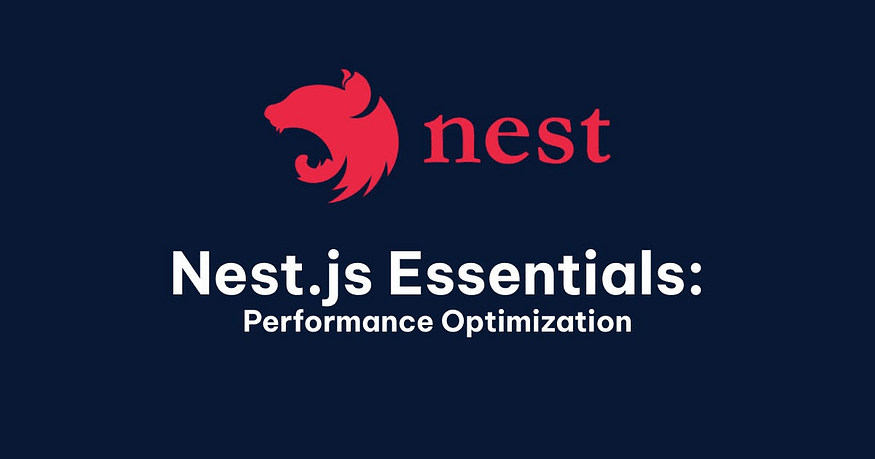
10 Tips to Boost Your NestJS API Performance
In modern web development, performance is crucial for delivering an optimal user experience. NestJS, a powerful and flexible Node.js framework, offers numerous possibilities for creating high-performance APIs. Here are 10 proven tips to maximize your NestJS API performance.
Table of Contents
- Smart Caching
- Query Optimization
- Lazy Loading
- Compression
- Load Balancing
- Asynchronous Code
- Data Streaming
- Message Brokers
- Middleware Optimization
- Performance Monitoring
1. Smart Caching
Caching is a powerful technique to improve performance by reducing the number of database queries. NestJS integrates seamlessly with Redis.
// Installation
// npm install @nestjs/cache-manager cache-manager redis
// app.module.ts
import { CacheModule } from '@nestjs/cache-manager';
import * as redisStore from 'cache-manager-redis-store';
@Module({
imports: [
CacheModule.register({
store: redisStore,
host: 'localhost',
port: 6379,
ttl: 60 * 60, // 1 hour
}),
],
})
export class AppModule {}
// users.controller.ts
@Controller('users')
@UseInterceptors(CacheInterceptor)
export class UsersController {
@Get()
@CacheTTL(30) // 30 seconds for this route
async findAll() {
return this.usersService.findAll();
}
}
2. Query Optimization
Optimized queries are essential for good performance.
// entity/user.entity.ts
@Entity()
export class User {
@Index(['email', 'status'])
@Column()
email: string;
@Column()
status: string;
}
// users.service.ts
@Injectable()
export class UsersService {
async findUsers(page = 1, limit = 10) {
const [users, total] = await this.userRepository
.createQueryBuilder('user')
.select(['user.id', 'user.email', 'user.status'])
.where('user.status = :status', { status: 'active' })
.take(limit)
.skip((page - 1) * limit)
.getManyAndCount();
return {
data: users,
meta: {
total,
page,
lastPage: Math.ceil(total / limit),
}
};
}
}
3. Lazy Loading
// app.module.ts
@Module({
imports: [
RouterModule.register([
{
path: 'users',
module: UsersModule,
children: [
{
path: 'profile',
module: UserProfileModule,
},
],
},
]),
],
})
export class AppModule {}
4. Compression
// main.ts
import * as compression from 'compression';
async function bootstrap() {
const app = await NestFactory.create(AppModule);
app.use(compression({
filter: shouldCompress,
threshold: 0,
level: 6,
}));
await app.listen(3000);
}
function shouldCompress(req, res) {
if (req.headers['x-no-compression']) {
return false;
}
return compression.filter(req, res);
}
bootstrap();
5. Load Balancing
The load balancing is crucial for the scalability of your API. Here is a robust configuration with Nginx and Docker.
# nginx.conf
http {
upstream nestjs_cluster {
least_conn; # Load distribution algorithm
server app1:3000;
server app2:3000;
server app3:3000;
keepalive 32; # Persistent connections
}
server {
listen 80;
server_name api.example.com;
location / {
proxy_pass http://nestjs_cluster;
proxy_http_version 1.1;
proxy_set_header Upgrade $http_upgrade;
proxy_set_header Connection 'upgrade';
proxy_set_header Host $host;
proxy_cache_bypass $http_upgrade;
proxy_set_header X-Real-IP $remote_addr;
# Configuration of timeouts
proxy_connect_timeout 60s;
proxy_send_timeout 60s;
proxy_read_timeout 60s;
}
}
}
# docker-compose.yml
version: '3.8'
services:
app1:
build: .
environment:
- NODE_ENV=production
- INSTANCE_ID=1
healthcheck:
test: ["CMD", "curl", "-f", "http://localhost:3000/health"]
interval: 30s
timeout: 10s
retries: 3
app2:
build: .
environment:
- NODE_ENV=production
- INSTANCE_ID=2
healthcheck:
test: ["CMD", "curl", "-f", "http://localhost:3000/health"]
interval: 30s
timeout: 10s
retries: 3
nginx:
image: nginx:alpine
volumes:
- ./nginx.conf:/etc/nginx/nginx.conf:ro
ports:
- "80:80"
depends_on:
- app1
- app2
6. Asynchronous Code
Optimizing asynchronous code is essential for the performance of your API.
// services/dashboard.service.ts
@Injectable()
export class DashboardService {
constructor(
private readonly usersService: UsersService,
private readonly ordersService: OrdersService,
private readonly analyticsService: AnalyticsService,
) {}
async getDashboardData(userId: string) {
// Parallel execution of independent queries
const [
userDetails,
recentOrders,
analytics
] = await Promise.all([
this.usersService.findById(userId),
this.ordersService.getRecentOrders(userId),
this.analyticsService.getUserMetrics(userId),
]);
// Conditional processing based on results
const enrichedOrders = await this.enrichOrdersData(recentOrders);
return {
user: userDetails,
orders: enrichedOrders,
metrics: analytics,
};
}
private async enrichOrdersData(orders: Order[]) {
return Promise.all(
orders.map(async (order) => ({
...order,
extendedInfo: await this.ordersService.getOrderDetails(order.id),
}))
);
}
}
7. Data Streaming
Streaming is ideal for efficiently handling large data sets.
// controllers/export.controller.ts
@Controller('export')
export class ExportController {
@Get('users')
async exportUsers(@Res() response: Response) {
response.setHeader('Content-Type', 'application/json');
response.setHeader('Transfer-Encoding', 'chunked');
const stream = this.userRepository.createQueryBuilder('user')
.stream();
response.write('[\n');
let isFirst = true;
return new Promise((resolve, reject) => {
stream.on('data', (user) => {
if (!isFirst) {
response.write(',\n');
}
isFirst = false;
response.write(JSON.stringify(user));
});
stream.on('end', () => {
response.write('\n]');
response.end();
resolve(true);
});
stream.on('error', (error) => {
reject(error);
});
});
}
}
8. Message Brokers
Using message brokers allows you to efficiently handle asynchronous tasks.
// config/rabbitmq.config.ts
import { ClientsModuleOptions, Transport } from '@nestjs/microservices';
export const rabbitmqConfig: ClientsModuleOptions = [
{
name: 'TASK_SERVICE',
transport: Transport.RMQ,
options: {
urls: [process.env.RABBITMQ_URL],
queue: 'tasks_queue',
queueOptions: {
durable: true,
deadLetterExchange: 'tasks.dlx',
deadLetterRoutingKey: 'tasks.dlq',
},
prefetchCount: 1,
noAck: false,
},
},
];
// services/task.service.ts
@Injectable()
export class TaskService {
constructor(
@Inject('TASK_SERVICE') private readonly client: ClientProxy,
) {}
async processLongRunningTask(data: any) {
return this.client.emit('process_task', {
id: uuid(),
data,
timestamp: new Date(),
});
}
}
9. Middleware Optimization
// middlewares/combined.middleware.ts
@Injectable()
export class CombinedMiddleware implements NestMiddleware {
constructor(
private readonly logger: Logger,
private readonly configService: ConfigService,
) {}
async use(req: Request, res: Response, next: NextFunction) {
const startTime = Date.now();
const requestId = uuid();
// Combine multiple middleware functionalities
this.addRequestContext(req, requestId);
await this.validateRequest(req);
this.setupResponseHeaders(res);
res.on('finish', () => {
const duration = Date.now() - startTime;
this.logRequest(req, res, duration, requestId);
});
next();
}
private addRequestContext(req: Request, requestId: string) {
req['context'] = {
requestId,
timestamp: new Date(),
correlationId: req.headers['x-correlation-id'] || requestId,
};
}
private async validateRequest(req: Request) {
// Validation logic here
}
private setupResponseHeaders(res: Response) {
res.setHeader('X-Content-Type-Options', 'nosniff');
res.setHeader('X-Frame-Options', 'DENY');
res.setHeader('X-XSS-Protection', '1; mode=block');
}
private logRequest(req: Request, res: Response, duration: number, requestId: string) {
this.logger.log({
requestId,
method: req.method,
url: req.url,
statusCode: res.statusCode,
duration,
userAgent: req.headers['user-agent'],
});
}
}
10. Performance Monitoring
// monitoring/metrics.service.ts
import { PrometheusHistogram } from 'prom-client';
@Injectable()
export class MetricsService {
private readonly httpRequestDuration: PrometheusHistogram;
constructor() {
this.httpRequestDuration = new PrometheusHistogram({
name: 'http_request_duration_seconds',
help: 'Duration of HTTP requests in seconds',
labelNames: ['method', 'route', 'status_code'],
buckets: [0.1, 0.3, 0.5, 0.7, 1, 3, 5, 7, 10],
});
}
recordHttpRequest(method: string, route: string, statusCode: number, duration: number) {
this.httpRequestDuration.labels(method, route, statusCode.toString())
.observe(duration / 1000);
}
}
// interceptors/metrics.interceptor.ts
@Injectable()
export class MetricsInterceptor implements NestInterceptor {
constructor(private metricsService: MetricsService) {}
intercept(context: ExecutionContext, next: CallHandler): Observable<any> {
const start = Date.now();
const http = context.switchToHttp();
const request = http.getRequest();
return next.handle().pipe(
tap(() => {
const duration = Date.now() - start;
const response = http.getResponse();
this.metricsService.recordHttpRequest(
request.method,
request.route.path,
response.statusCode,
duration,
);
}),
);
}
}
Conclusion
Optimizing a NestJS API's performance requires a multifaceted approach and careful attention to detail. By thoughtfully applying these ten techniques and adapting them to your specific needs, you can build robust, high-performance, and easily maintainable APIs.
Remember that optimization is an ongoing process. Regularly monitor your performance metrics, identify bottlenecks, and adjust your implementation accordingly.


